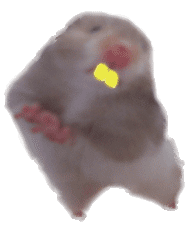| |
A Hamsters Teeth

A hamster with a curling incisor tooth |
| |
|
Hamsters are mammals which belong to the rodent family and are notorious for gnawing, as are all rodents. The word 'Rodent' is derived from the Latin word 'Rodere' which means to gnaw. Hamsters are born with teeth and keep the same set throughout their life. The two incisors in the upper and lower jaw continuously grow throughout the life of the hamster. These normally receive continuous wear as the upper and lower contact each other. Gnawing also helps to maintain a relatively constant length. Some say place a piece of wood or hamster chews in the cage for them to gnaw on, but they always seem to prefer the metal bars or plastic part of the cage to gnaw on.
Problems with teeth rarely give cause for concern but there are exceptional circumstances where a hamster' teeth may become too long and overgrown. This may cause problems with eating resulting in weight loss, mouth infections, and abscesses may occur.
It is important that the teeth should be examined regularly for any abnormalities, particularly as he advances into old age, as the teeth are more prone to breaking and becoming crooked. Watch for signs of drooling (slobber) excessive amounts of saliva trailing from the mouth and difficulty in eating or not eating at all with a reluctance or the inability to close the mouth completely.
Teeth can become overgrown through being broken or misaligned.
Malocclusion is a condition in which the opposing teeth are not properly aligned. The two incisors in the upper and lower jaw continuously grow throughout the life of the hamster and will normally receive continuous wear as the upper and lower set contact each other during normal day to day activities such as eating and gnawing etc: However, if the problem is essentially one of malocclusion (as seen here in this Video then regular teeth clipping may be required as the teeth will not wear down naturally and will continue to grow. Malocclusion can occur due to several reasons including genetics and trauma to the teeth, but is most often a hereditary condition. If overgrowth does occur then the situation may deteriorate as the teeth continue to grow the hamster may find it difficult to eat, this can lead to weight loss, abscesses, malnutrition and the inability to close the mouth.
The teeth may need to be trimmed by a veterinarian to prevent further problems. Not everyone may need a vet in which to clip the hamster’s teeth. However, it is highly recommended that an inexperienced person should “Never” attempt to reduce the size of a hamsters’ teeth for the first time. The teeth have a consistency of glass and may shatter below the gum line if cut to short. Your veterinary surgeon will advise you on this and for future reference he may show you how to clip the hamster’s teeth correctly.
How long is too long? Sometimes it is difficult for a person to determine if their hamster’s teeth are becoming too long or not. One way to assess this is to offer your hamster a treat, say for instance a monkey nut still in the shell; the hamster should be able to take it from you without any difficulty by grasping the nut in the upper and lower teeth very easily. Difficulty in opening the jaws, or mouth, wide enough to grasp the nut, or any attempt to tuck it in behind the elongated teeth would suggest that the teeth are becoming too long.
 |
Even though it is a relatively simple task teeth clipping should be left to experienced breeders and veterinary surgeons. For those who may not feel confident enough in which to carry it out should seek professional help and advice from their vet. He may show how to do it correctly for future reference.
Some hamster owners become concerned about the yellow colour of the teeth; the hamster’s teeth are normally yellow and this is nothing to be concerned about.
|
|


